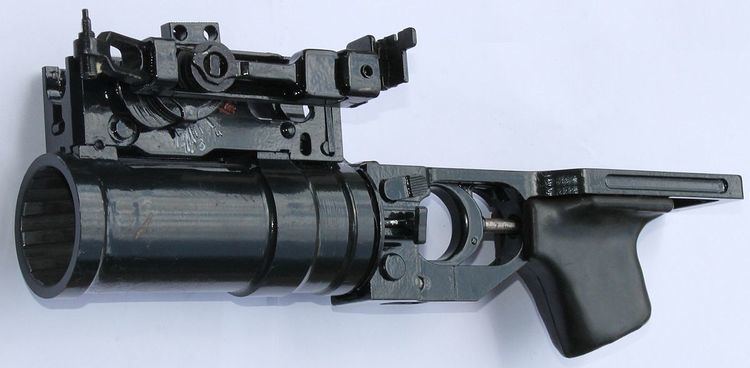In service 1978–present Designer TsKIB SOO | Used by See Users | |
 | ||
Wars Soviet–Afghan WarFirst Chechen warSecond Chechen WarRusso-Georgian WarWar in DonbassSyrian Civil War | ||
The GP-25 Kostyor ('Bonfire'), GP-30 Obuvka ('Shoe') and GP-34 are Russian 40 mm under-barrel grenade launchers (Granatomyot Podstvolnyj) for the AK-series of assault rifle. They were first seen by the west in 1984 during the Soviet Invasion of Afghanistan. The initial version was designated BG-15 Mukha ('Fly'), and was fitted under the barrel of AK-74 assault rifles. The main production version, the GP-25, has a different sighting system. The GP-30 was lightened and the redesigned sighting system was moved to the right.
Contents
The current Izhmash-made version, the GP-34, has an again redesigned sighting system on the right and features the following advantages:
Development
Development of a grenade launcher for the AK-47 assault rifle began in 1966 at the Sporting and Hunting Arms Central Design and Research Bureau. Development continued into the 1970s, and in 1978 it was accepted into service. The GP-30 first entered service in 1989, and is intended for use with the AK-100 series of assault rifles. The GP-34 is designed to be a universal service model that can be fitted to the AKM / AKMS, AK74 / AK74S, AK74M, AK-101, AK-103, and AN-94 Nikonova rifles.
Description
The grenade launchers are similar in appearance and fire the same 40 mm caliber ammunition and use the same High-Low System developed by Germany in late World War II to keep recoil forces low without a rocket or other type of recoilless weapon back blast.
The GP-30 is a stripped-down model grenade launcher, consisting of a very short, 40 mm rifled barrel in front of a basic trigger mechanism with minimal hand grip. On top of the barrel is mounting gear to attach the weapon under the barrel of an AK-series assault rifle, from where it is designed to be fired.
A grenade is first muzzle loaded into the barrel, the weapon is aimed, then the self-cocking trigger is pulled to fire the weapon. This fires the percussion cap at the base of the grenade which triggers the nitrocellulose propellant inside the body of the grenade. The hot expanding gas from the propellant is forced through vents in the base of the grenade that move the grenade along the barrel, and at the same time force the driving band to engage with the twelve rifling grooves. The rifling imparts stabilizing spin to the projectile.
The barrel has a life of about 400 rounds.
Ammunition
The grenade launchers fire a series of special 40 mm grenades. Originally, the main grenade was the VOG-15 (7P17) fragmentation grenade. This was superseded by the steel-cased VOG-25 fragmentation grenade. The VOG-25 has a lethal radius of six meters. Rounds for the muzzle-loaded GP-25 consist of a single piece containing both propellant and warhead, unlike the more traditional two piece casing-and-projectile design of the comparable American 40x46mm round used in breech-loaded grenade launchers, such as the M203.
A bouncing grenade, the VOG-25P, is also available. On impact, a small charge in the nose of the grenade is detonated; this raises the grenade 0.5 to 1.5 m in the air, before an impact delay fuse detonates it. The VOG-25P also has a lethal radius of 6 meters.
New generation rounds VOG-M and VOG-PM with an increased effectiveness not less than 1.5 times are now serially available.
Smoke grenades are also available. The original GRD-40 grenade has been replaced by a series of grenades designed for use at different ranges; these are the GRD-50, GRD-100 and GRD-200 for use at 50, 100 and 200 meters respectively. They are capable of producing a 20 square meter cloud of smoke that lasts for one minute in winds of up to five meters per second.
A CS gas grenade called the Gvozd ("Nail") and a baton grenade are also available.
